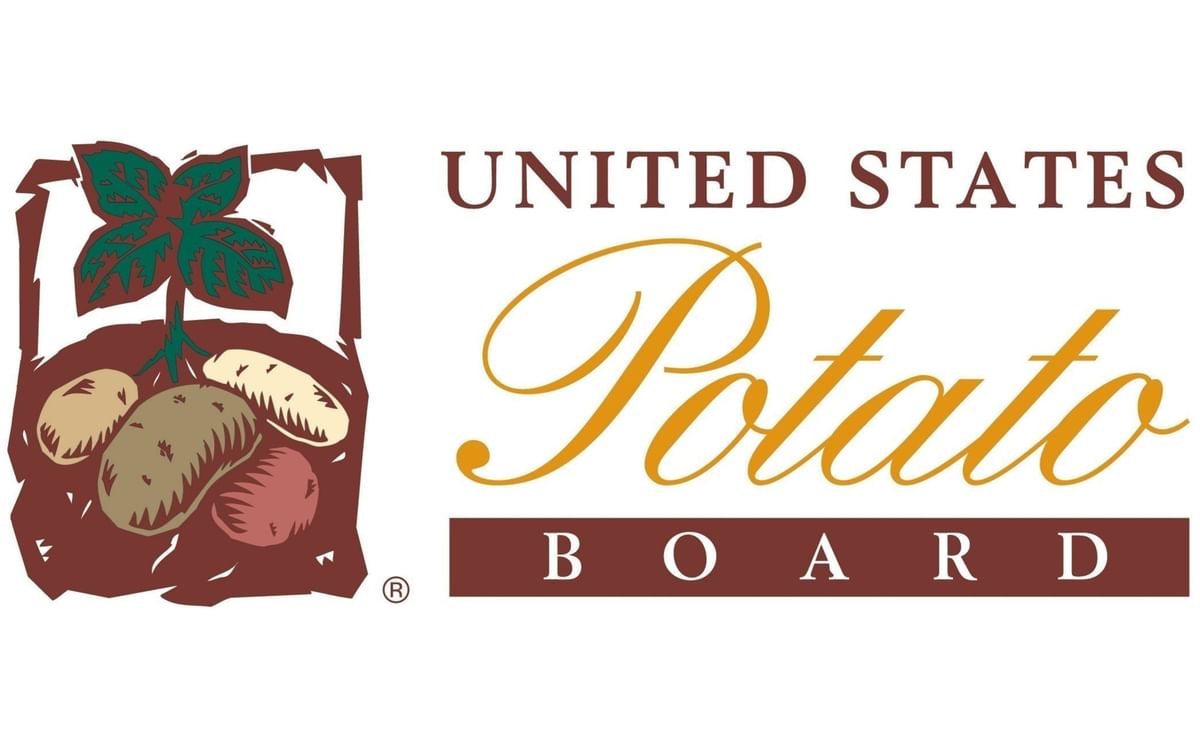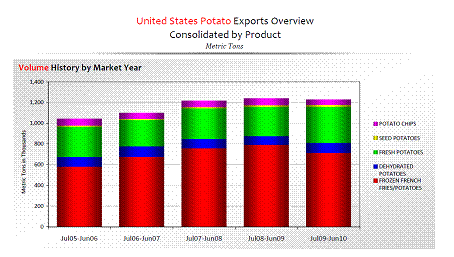United States Potato Board (USPB)
US export of potato products remains strong

Exports of US potatoes and products for July 2009 through June 2010 (MY09/10) totaled 1,229,853 metric tons (MT) valued at $1,172,702,250.
This is a decline of 0.67 percent in volume and 2.69 percent in value from the previous year’s record levels.
On a fresh weight equivalent basis, exports accounted for 53,074,809 hundredweight of US potatoes leaving the country, or roughly 15 percent of total production. The slight decline in exports is mainly attributable to a 22 percent reduction in the volume of potato chip (mainly fabricated) exports and a 10 percent decline in the volume of frozen potato exports stemming from the 41 percent reduction to Mexico. The export volume of fresh potatoes was up 24 percent, while dehy volume increased 14 percent.

Export Potato and potato products by United States
US exports of frozen potato products for MY09/10 were 715,036 MT valued at $729 million, an increase in value of 1.24 percent. The continued increase in value of US frozen potato exports is due to the increase in the unit value from $908/MT to $1,020/MT. This higher price placed US product at a competitive disadvantage to product from the EU with a unit value of $753/MT and Canada at $914/MT.
Export volume to Japan, the largest US market, declined 3 percent to 285,538 MT, mirroring the 3 percent decline in total exports to the market, due to continued economic stagnation. The imposition by Mexico of a 20 percent retaliatory tariff on US frozen potato products in response to the cancellation by the US government of the NAFTA-mandated pilot program to allow Mexican trucks to operate in the US resulted in a 41 percent reduction in US exports to Mexico to 45,301 MT. Meanwhile exports from Canada increased 39 percent to 57,052 MT, the first time Canada has had the larger share in Mexico. It is a credit to the United States Potato Board (USPB) representative’s dogged efforts in the market that US exports did not fall even further.
South Korea moved into the number 4 spot with a 31 percent increase in US exports to 44,616 MT, while exports to China grew by 15 percent to 44,013 MT. In both markets the USPB program is focused on diversifying the use of US frozen potato products to local cuisine and alternative channels. Exports to the CAFTA-DR countries, where the USPB initiated a marketing program in 2008/09, grew 18 percent to 24,170 MT. Canada and the EU still retain roughly two-thirds of these markets, providing an opportunity for the US to not only benefit from growth in the markets but also increase market share.
Exports of dehydrated potatoes increased 14 percent in volume to 96,193 MT, the fresh weight equivalent of 13,793,114 hundredweight. The value of US dehy exports rose 19 percent to $157 million, reflecting the continued rise in dehy prices. Exports to Canada (some of which are transshipped to other countries) increased 14 percent to 27,340 MT. Exports to Mexico increased 61 percent to 20,671 MT, while exports to Japan increased 38 percent to 18,422 MT. The USPB carries out extensive marketing and promotion programs in these two markets which have resulted in the launch of 10 new products and numerous new menu items made with US dehydrated potatoes.
Reflecting lower US prices, exports of fresh potatoes increased 24 percent in volume to a record 350,895 MT, while declining 10 percent in value to $139 million. Fresh potato exports include both table-stock potatoes as well as potatoes destined for processing either into chips, or in the case of Canada, frozen products. Exports to Canada were up 27 percent to 224,599 MT while exports to Mexico grew 59 percent to 73,253 MT. This figure would be significantly higher if US exports were not limited to the 26 kilometer border area. The target markets for USPB promotional work for table-stock and chipping potatoes all showed increases from 4 percent in Malaysia to 75 percent in the Philippines. Exports of chipping potatoes to Thailand and the Dominican Republic declined as the result of quality issues upon arrival of initial shipments in October. Chipping potato exports to Japan reached a record 2,357 MT and are poised to increase again in the coming February–June shipping season.
Exports of finished potato chips, for which the USPB does not have an international marketing program, dropped by 21 percent to 48,630 MT, valued at $138 million. The reduction was due to significant declines to Canada, 7 percent;Japan, 67 percent and South Korea, 70 percent. Exports to Mexico did grow 138 percent to 13,121 MT.
Seed potato exports increased 13 percent to 18,890 MT, valued at $10 million. Unfortunately, US Customs data for seed potatoes is not completely accurate as fresh potatoes get mistakenly categorized as seed potatoes and visa-a-versa. USPB programs in Central America, Uruguay, Brazil and Sri Lanka have all led to increased exports over time.
US exports in MY 2010/11 will be impacted by the US supply situation, continued high prices for processed products, tariff disadvantages in Thailand and Mexico and, possibly, South Korea and Central America. Quotas and other restrictions in South Korea, Japan, Mexico, China and many other countries will also continue to hinder exports. The USPB, in conjunction with the National Potato Council and state potato grower organizations, will continue to work with USDA to get these barriers removed or reduced.
The world-wide economic recovery should lead to an increase in demand for US potatoes and products. The reduction of the retaliatory tariff on US frozen potatoes by Mexico to 5 percent should result in recovered exports to this market. Projected declines in potato production in the EU and Canada may also limit supplies available for export from these countries while also raising their prices.
The USPB International Marketing Program will continue to focus on increasing demand for US potatoes and products by introducing new products, opening new channels and finding new uses. Market share will be maintained or increased through the delivery of added value services such as restaurant training and promotional assistance, as well as messages on the higher quality and profitability of US products. New customers will be reached through participation in trade shows, websites, newsletters and seminars. Buyers and sellers will be brought together through trade missions to foreign markets and reverse trade missions to the US. Overall demand for potatoes products will be increased through positive nutrition messages and issues management work.






